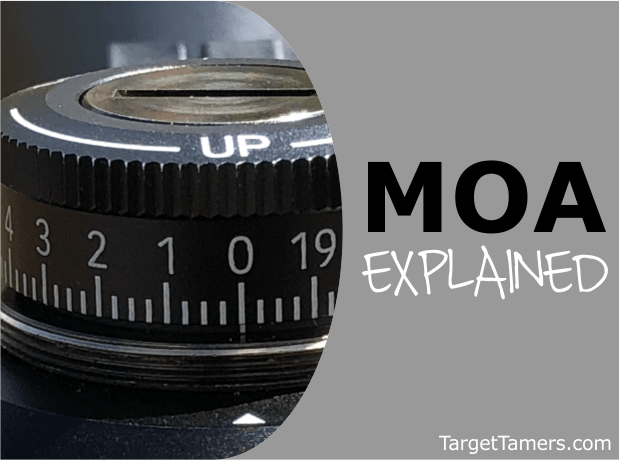
You hear about MOA all the time, but do you know what it is?
Is math important to make turret adjustments?
Will it complicate your shooting experience, or will it improve accuracy?
We provide simple examples and formulas for cracking the MOA code. Let's break MOA down in layman's terms to help you get dead on.
Here it is... MOA for dummies.
What is MOA?
So what is MOA? MOA is an acronym for Minutes of Angle. 1 minute is a shooter's term for 1/60th degrees in an angle.
We usually think of minutes in relation to telling the time. However, for shooters minutes relates to a very small degree in an angle, and it can get even smaller with seconds.
As we know, there's 360 degrees in a circle, 180 degrees in half a circle, 90 degrees in a quarter circle, and so on. Measuring 1/60th degrees is incredibly small, but each minute can make a huge difference down range.
This begs the question...
why is shooting measured in minutes and angles?
Bullet trajectory happens in an arc thanks to gravity. The faster the bullet goes, the less of an effect gravity has on that bullet, and at longer distances bullet velocity will slow and gravity will pull it down.
Therefore, you may shoot close to or dead on your target at closer ranges like 100 yards and then see you're shooting way too low at 500 yards. The measurement in inches of where you were aiming and where the bullet hits is called bullet drop.
Because bullet trajectory happens in an arc consequential to gravity, we measure that arc in degrees and angles to better compensate for bullet drop to get dead on. MOA is especially useful in shooting because it works cohesively with the inch measuring system in the United States.
MOA vs Distance
How much does a minute measure in terms of distance?
MOA is independent of distance. Don't get your panties in a bunch just yet. Hear us out.
MOA is an angular measurement, and we use it on scopes to make angular adjustments. You adjust via the turrets. With that said, we can use MOA to translate into a linear measurement downrange.
The rule is 1 MOA or 1 minute is equal to 1 inch at 100 yards. 1 inch is an approximate as 1 MOA is exactly 1.047 inches. But, for most hunting and shooting applications within an appropriate range, it's acceptable to round to 1 inch.
What does this mean? It means when you make a 1 minute adjustment to your scope, you can expect a 1 inch change of bullet impact at 100 yards. However, the size of 1 MOA will change at various distances.
1 MOA Size Chart
| Distance | MOA Size (Rounded) | MOA Size (Exact) |
|---|---|---|
| 100 Yards | 1 Inch | 1.047 Inch |
| 200 Yards | 2 Inch | 2.094 Inch |
| 300 Yards | 3 Inch | 3.141 Inch |
| 400 Yards | 4 Inch | 4.188 Inch |
| 500 Yards | 5 Inch | 5.235 Inch |
| 600 Yards | 6 Inch | 6.282 Inch |
| 700 Yards | 7 Inch | 7.329 Inch |
| 800 Yards | 8 Inch | 8.376 Inch |
| 900 Yards | 9 Inch | 9.423 Inch |
| 1000 Yards | 10 Inch | 10.47 Inch |
And so on. As you can see, an angle adjustment in the scope translates to a size at a certain distance.
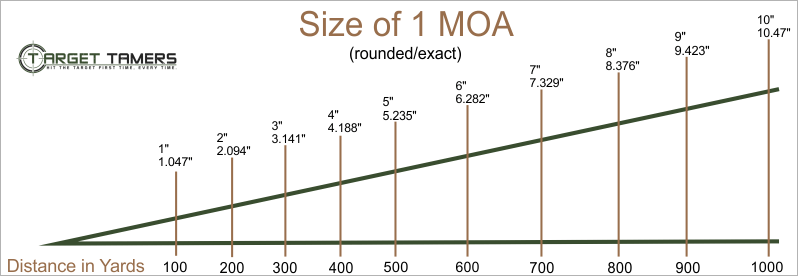
What Is MOA: Understanding Minute of Angle
Why do you need MOA? Why does MOA matter?
If you want to shoot accurately every time, you'll need to understand MOA to compensate for bullet drop. The elevation turret is the knob that sits on top of the scope to make MOA changes. Knowing how to use it effectively allows the shooter to use their scope to its full potential.
The first thing you must know to compensate for bullet drop is to know what your bullet drop actually is.
Go to the range and pop off some rounds! Now, we need to know what distance you’re shooting your targets and what your bullet drop is. Then you want to memorize what size 1 MOA translates to at that given distance. (See 1 MOA Size Chart above.)
For example, if you're shooting at 200 yards and you're missing the bull's-eye at 2" too low, you're going to have to make an adjustment to get on dead-on.
As we know from the chart above, 1 MOA translates into 2 inches at 200 yards. To compensate for 2 inches, you need to come up 1 MOA. Easy enough? Just in case, here’s a formula to figure out the size of 1 MOA at any known distance:
FORMULA: CALCULATE 1 MOA SIZE AT ANY KNOWN DISTANCE (Rounded)
Target distance (yards) / (divide by) 100 = inches per 1 MOA at that distance.
For example: 500 yards to bull's-eye / 100 = 5 inches.
We now know 1 MOA translates into 5 inches at 500 yards. This means you need 1 MOA for every 5 inches you are off target to get on dead-on.
For exacting measurements using the 1.047” = 1 MOA rule, use this formula:
FORMULA: CALCULATE 1 MOA SIZE AT ANY KNOWN DISTANCE (Exacting)
(Target distance (yards) x 1.047) / 100 = inches per 1 MOA at that distance
For example: (500 x 1.047) / 100 = 5.2 inches
Now what do you do with those numbers? You have 500 yards, and you know you’ll need 1 MOA for every 5 inches you’re low. What’s your bullet drop? Let’s go with 60 inches in this example.
To compensate for bullet drop, here's another formula:
FORMULA: CALCULATE MOA ADJUSTMENTS TO COMPENSATE FOR BULLET DROP
Number of inches of adjustment needed / inches of MOA at that distance = your needed MOA adjustment
60 inches too low / 5 inches (of MOA for every 1 MOA at 500 yards) = 12 MOA of adjustments needed
Now that you know the numbers, how do we translate this into physically making adjustments on a scope?
Reading MOA Turrets
These days, most scopes are made with ¼ MOA turrets. There are also ½ MOA, 1 MOA, and even very fine 1/8 MOA turrets available. What does this mean? It means the turret will turn in ¼, ½, 1, and 1/8 MOA increments.
Don’t feel overwhelmed by all the lines and numbers on your turrets. You’ll see small lines and larger lines. The larger ones usually indicate a full MOA, and the smaller lines indicate the click rotations within one MOA.
Each time you turn the turret it will click, and the turret will move to the next small or big line. These "clicks" are how you make the physical MOA adjustments on the scope.
For example: on a ¼ MOA turret, we know there are four quarters in a whole to make 1. Therefore, four ¼ minute clicks are equivalent to making a full 1 minute adjustment regardless of distance.
On a ¼ MOA turret, it will always require 4 clicks to make 1 MOA. On a ½ MOA turret, it will always require 2 clicks to make 1 MOA. On a 1 MOA turret, it will always require 1 click to make 1 MOA. Get the idea?
When you throw distance into the mix, you can see how clicks translate to inches downrange.
For example: On a ¼ MOA turret at 100 yards each click translates to a ¼ inch. This means you can make one click and expect a ¼ inch change in where your bullet hits your target.
4 clicks equal 1 MOA, and we know 1 MOA is 1 inch at 100 yards. You can now expect a 1-inch change in where your bullet hits your target. 8 clicks equal 2 MOA and is 2 inches at 100 yards. 12 clicks equal 3 MOA and is 3 inches at 100 yards.
To reiterate this point, the size of a MOA changes with distance. The number of clicks in a MOA will always remain the same. We can use this measuring system to compensate for bullet drop at any known distance to refine shooting accuracy.
Tips for Using MOA
To bring everything together, you have to know the distance (which you can do with a laser rangefinder, by the way) and your bullet drop. Then you can calculate how much MOA adjustments you need and then calculate how many clicks that translates into. To keep things simple, follow these tips:
- Know your distance and bullet drop
- Figure out how many inches 1 MOA calculates to at that distance
- Figure out how many MOA adjustments that translates for you
- Figure out the amount of clicks you need to make.
Let's run through a scenario.
Distance: 300 Yards // Bullet Drop: 15 Inches
Step 1: What's the distance?
300 yards
Step 2: Calculate how many inches 1 MOA translates to at 300 yards.
300 yards / 100 = 3 inches
Step 3: Calculate how many MOA you need to make.
15 inches too low / 3 inches = 5 MOA
Step 4: Calculate how many clicks you need to make.
Adjustments needed: 5 MOA.
On a ¼ MOA turret, we know there are 4 clicks per 1 MOA: 5 x 4 = 20 clicks.
On a ½ MOA turret, we know there are 2 clicks per 1 MOA: 5 x 2 = 10 clicks.
On a 1 MOA turret, we know there is 1 click per 1 MOA: 5 x 1 = 5 clicks.
Step 5: Make the adjustments and...
Shoot
Long Range MOA Turrets
Do things change when you’re shooting out long range? No. The formulas stay the same. However, such long distances above 1000 yards requires more measuring accuracy than rounding to the inch for what we would do for much shorter yardages. For this reason, we’re going to work with the precise 1.047-inch MOA size per 100 yards to get dead-on.
Things may get confusing when you’re trying to correct for bullet drop at distances like 1000 yards when you have something like 400 inches of drop and 50 MOA to adjust.
It’s all fine and dandy when you can make clicks within one revolution. For example, your ballistics calculator says you need to come up 12 MOA to hit the bull’s-eye. Essentially, the number “12” line on your scope tells you that you need to be there to see the adjustment for 12 MOA. On a ¼ MOA scope, 12 x 4 (4 clicks per MOA) = 48 clicks from your zero to get to and adjust for 12 MOA.
Hold on a second – what’s a revolution?
A revolution or rev (as we like to say) is a full spin of the turret. If you look at the numbers on my scope, you’ll see it starts from 0 and ends at 19. However, it really ends at 20 because it’s in the same spot as “0.” So, is my scope only capable of adjusting up to 20 MOA?
No. I can keep spinning the turret past 20 or 0. As I do that, the turret will rise. Each time you pass 0, you’re in the next revolution. Some scopes will have horizontal lines that are visible as the turret goes into the next revolution.
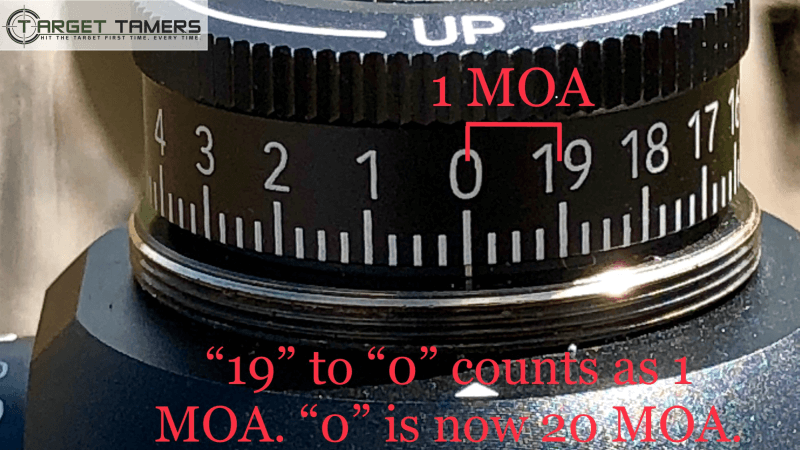
But, what does this have to do with long range shots? How do you make sense of these seemingly large adjustment numbers?
Hypothetical example: Let’s look at a 308 Win. with 150g loads at 5000 ft elevation – let’s ignore the wind and pretend it’s 0 mph across the board. I’m at the range and am recording for drop out to 1000 yards. Let’s look at what numbers I’m dealing with here.
Distance: 1000 yards // Bullet Drop: 497.8-inches // Adjustment: 47.5 MOA
How do we know we need to come up 47.5 MOA? You can use an online ballistics calculator, or you can do the math yourself. The formulas and 1 MOA Size Chart above tell us 1 MOA at 1000 yards is exactly 10.47 inches.
I take my bullet drop of 497.8 inches / 10.47 = 47.5 MOA of adjustment needed.
We now know we need to come up 47.5 MOA to correct for almost 498 inches of drop. Sheesh. Anyone got a turret with a number reference that goes all the way to 50? Didn’t think so.
Now, what the heck is that in clicks? 47.5 x 4 on a ¼ MOA scope means making 190 clicks. Woo wee! This is when you need to pay attention to revolutions.
Let’s try it.
Side note: On my scope, I don’t have horizontal lines under my turret that shows what rev I’m on. I just pay attention to how many times I pass 0.
If you don’t have rev markers, an option is to manually use a white fine paint marker to draw the line level on the turret tube for fast, visual reference. However, you may be voiding your warranty by doing this.
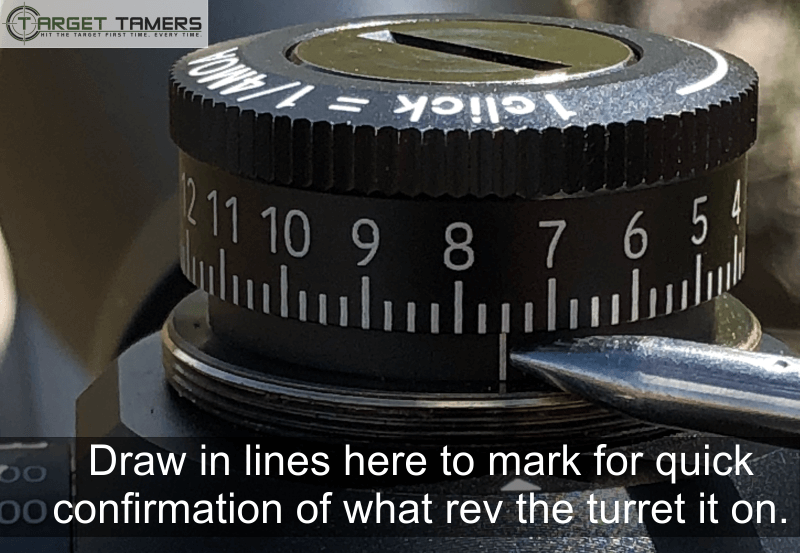
Back to it - I make 190 clicks to get to 47.5 MOA to correct for 497.8 inches of drop at 1000 yards. You can tediously count every single click, but who wants to do that?
I already know that it takes 80 clicks to get through a full 20 MOA in one revolution. How do I know this? Well, I can count each click until I get back to 0 again, or I can do the math. 20 MOA x 4 (clicks per 1 MOA) = 80 clicks. Voila.
If I start at 0, and then turn the turret all the way to 0 again, I’ve made 80 clicks that is the same as 20 MOA or 1 revolution. I spin the turret all the way to 0 again, and I’ve made 160 clicks that is the same as 40 MOA or 2 revolutions.
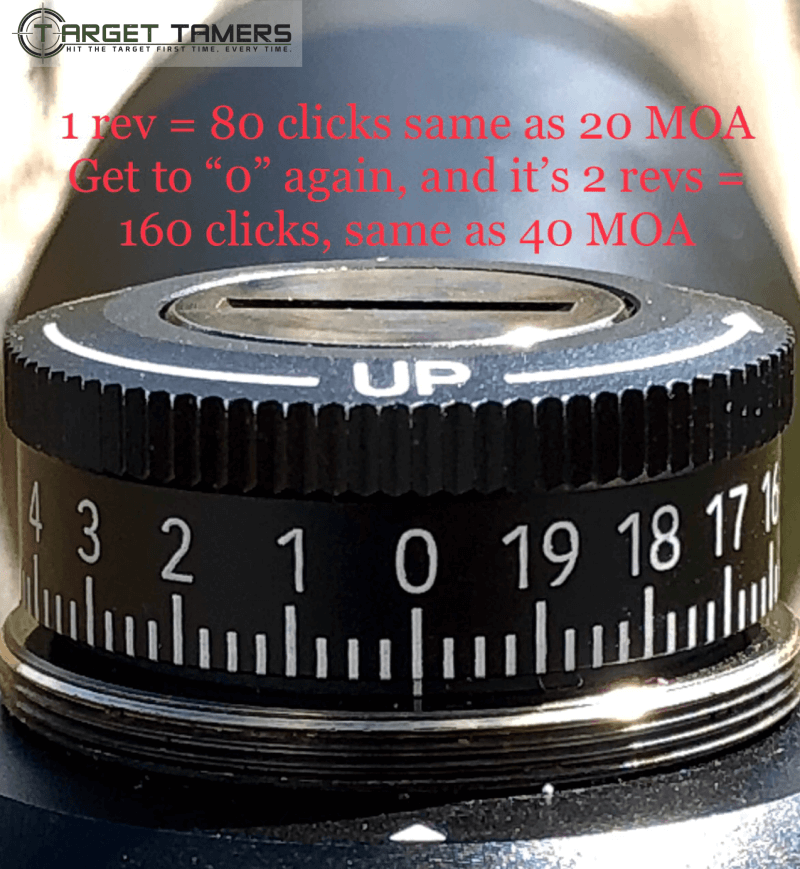
I make another 30 clicks to get to a total of 190 clicks. My turret now says I’m sitting at 7 ½ MOA or 7 MOA and 2 clicks, and I know I’m on the second revolution. Now, I want to write this down on my dope card.
What would my dope card look like?
| Distance | Bullet Drop | Elevation | Adjustments |
|---|---|---|---|
| 800 yards | 248.1 Inches | 29.6 MOA | (118 Clicks) 1 Rev, 9 MOA, plus 2 clicks |
| 900 yards | 357.7 Inches | 38 MOA | (152 Clicks) 1 Rev, 18 MOA |
| 1000 yards | 497.8 Inches | 47.5 MOA | (190 Clicks) 2 Rev, 7 MOA, plus 2 clicks |
It's tedious to count in clicks to yourself. You'll be counting a lot, and what happens when you forget where you are? It's better to think in revolutions, MOA, and then clicks. That way, you know exactly where you’re meant to be.
It takes practice and trial and error to get comfortable with all of this. Knowing this on paper is one thing, but it’s another to apply it in the field.
Add to that stress, adrenaline, weather, and terrain when you’re hunting, and your brain might just fizzle out. This is why you want to get to the range, do some practice, burn some ammo, and fill out your dope card for future reference.
MOA & Wind
I haven’t said anything on wind. It’s a topic of its own that includes additional formulas, judging wind speed, direction, and angles. Most people use the aiming dots on the reticle to hold off for wind, meaning they don’t usually fiddle with the windage turret. Shooters call this the Kentucky Windage method.
Instead of using the center dot and making adjustments with the windage turret, the shooter would move left or right to the appropriate dot on the windage crosshair to compensate for wind. That new dot becomes the aiming point to get on target. This is a quick and fast method to use when out in the field.
However, you can use your windage turret just like the elevation turret to adjust for wind. If you use a ballistic calculator that provides a wind drift MOA adjustment, just turn your turret in the correct direction of MOA to compensate for wind drift. It does take extra time, but it really depends on the conditions, type of shooting, and hunting activity that necessitates such precision.
MOA Reticle
A MOA reticle can be simple, or it can be complicated and busy. Each marker on the crosshair will indicate a MOA increment and distance. Each MOA reticle will be different to another model, scope, and manufacturer, and the increments and distances marked on the crosshair will also vary depending on complexity, activity, and level of accuracy desired.
Some reticles are specifically made for certain rifles and loads, while others will be generic, and you’ll have to confirm accurate distances and bullet drops at the range.

You must also consider whether you have an FFP (first focal plane) scope or SFP (second focal plane) reticle. Suffice it to say, having an FFP reticle enables a shooter to use their MOA reticle effectively and accurately at any magnification.
If you have an SFP scope, the MOA reticle is at its most accurate at maximum power. Without getting technical, it’s just the way is because of where the reticle sits in the erector tube.
But, is it always helpful to be at max power to use the reticle and MOA? Long range shooting says it can be since you need the higher magnification to see at long distances anyway. But, sometimes excessive mirage, scope wobble, and various other factors make it impractical to use max power.
What do you do now? If you know your scope’s subtension values at max power, you can come down to half power and double subtension values. The only problem is, some scopes just don’t have the quality to truly be at half power (even if the magnification setting says it is) to depend on doubled subtension values. It’s a gamble, but a good one if you can get to the range to confirm your values and distances.
How do you know what subtension values are? When buying your MOA rifle scope online, look for the manufacturer-provided image of reticle subtension on the product page. It might also be in your scope’s user manual.
MOA & Scope Quality
Will all scopes be accurate? This is a question that shooters refer to as "tracking." The most common questions about this are:
- Can the scope track consistently?
- Is it repeatable?
- Is the scope accurate?
- How accurate is the scope?
This really depends on a couple factors that includes how dependable an erector tube is. Some cheap scopes aren’t durable enough to endure heavy and repeated recoil causing springs and assemblies to come out of place in the tube. This ultimately leads to inconsistent tracking, adjustments, and you can’t zero your scope which means you can’t get dead-on.
Another factor is what measurement increments your scope provides MOA. 1 MOA scopes are fine for most big game hunting applications. Longer ranges will require fine adjustments. ¼ MOA scopes provide for fine adjustments, and there are even 1/8 MOA scopes that provide for even finer adjustments.
How will you know what the MOA measurements are on a scope?
You can find this in the user manual, on the specs page of an online scope, or you can simply unscrew the turret cap and look for the reference marking.
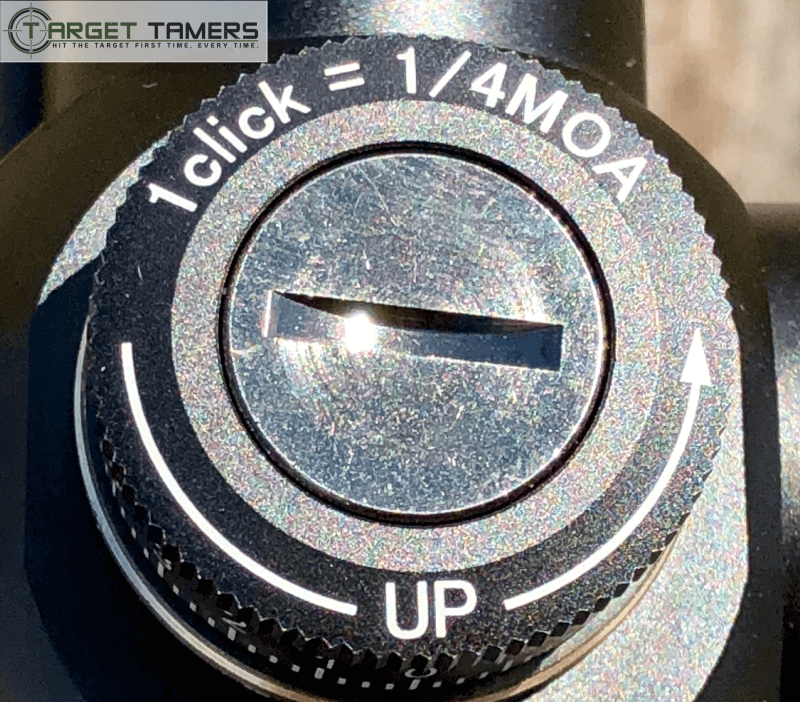
But, consistence, repeatability, and accuracy really comes down to the quality of a scope. High end scopes should be pretty darn dead on with high accuracy and tracking consistency. Lower quality scopes may be less accurate.
When you make a 1 MOA adjustment on your scope, it may not translate to exactly 1.047 inches at 100 yards. It's just the way the scope and internal components were made.
However, with that said, there are some high-end scopes that have difficulty with accuracy, too. The only way to know is to test it out yourself, see what others have said, or to read our reviews.
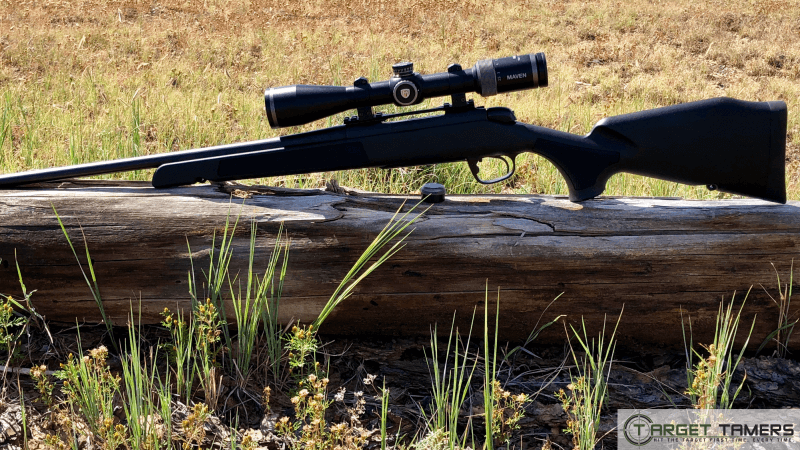
Meaning of Accuracy
It takes practice at the range and getting intimate with your rifle, scope, and bullets. Being able to predict how these tools will work at given distances can help you to feel comfortable with understanding MOA.
You can use manufacturer online ballistics charts to provide your MOA adjustments and even number of clicks. In any case, there's no way in getting around MOA if you want to hit where you're aiming. What are you waiting for? Get to the range!
Further Reading
- Wire vs Glass Etched Reticles: Which Should You Choose for Your Rifle Scope?
- What Is Your Best Hunting Gear Investment? 25 Expert Hunters Weigh In
- What is the Sight Picture & Sight Alignment? [WITH PICS]
- What Is The Difference Between Reflex Sights VS Red Dot? Find Out Here!
- What Is MOA? Calculating Minutes of Angle & Making Turret Adjustments

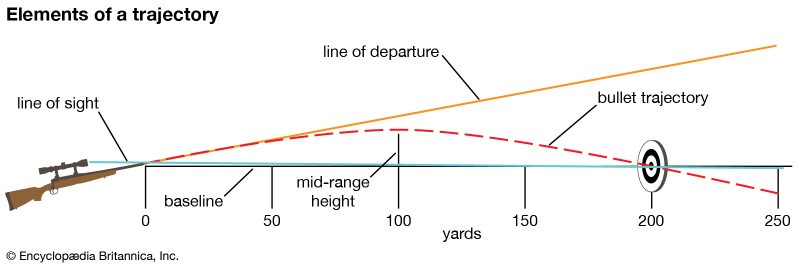

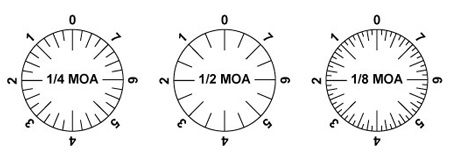




Good write up.
The only thing I wish you'd covered for folks is a "truth stick" at exactly 100 yards, or meters. Depends on if US mils, or finer Russian based increments of measure.
James, thanks for the comment – that’s not a bad idea. Turret tracking and accuracy is essential and using a truth stick can be telling. I have not used one myself, but it may be a good excuse to put some turrets and manufacturer claims to the test using this method.
Great read for a good foundation of long range MOA calculations. Even for some of us that have been shooting long range and simply looking at our phones, grabbing the dope, and spinning adjustments. Nothing wrong with reading the basics again for sure.
Thank you for your time in putting this together.
Thanks for the feedback Shawn (Just One More NightForce Dear) - Lol!
Glad you found the article useful!
best simple but foundational explanation I found over the internet, it helps a lot for the beginners, keep up the good job
Thanks very much for your kind feedback!
I've read sooo many articles about this topic but this is probably the most "understandable" I've found, great write-up, thanks!
Glad you found it helpful, thanks for letting us know!
Let me say, this is the most comprehensive, easy to understand dissertation about using our scopes effectively. Though I use air rifles, primarily I need to understand the use of optics.
I wish you could cover about making turret tapes or labels which we can wrap around our elevation knobs.
Thanks for your kind feedback David!
I will add information about making turret tapes to our 'to do' list. Thanks for the idea!
Very well written article, thank you for the information.
I'm glad you enjoyed it! Thanks for your kind comment Scotch.
Hope I didn't miss the elevation or windge, which way to turn the turrets to get the point of aim exactly where you want the bullet to land.
Hi Peter, if I understand your comment right, I believe it's a question? There should be markings on the turrets to indicate which way is up/down on the elevation turret and right/left on the windage. Usually, you must turn the turrets counterclockwise to bring the POI up and right. Turn turrets clockwise for down and left adjustments. If they don't have arrows or you can't tell by the numbers on your turrets, the user manual should confirm. Quick example to complete my answer to you: if your POI is high and right, dial down and left. Hope that helps!